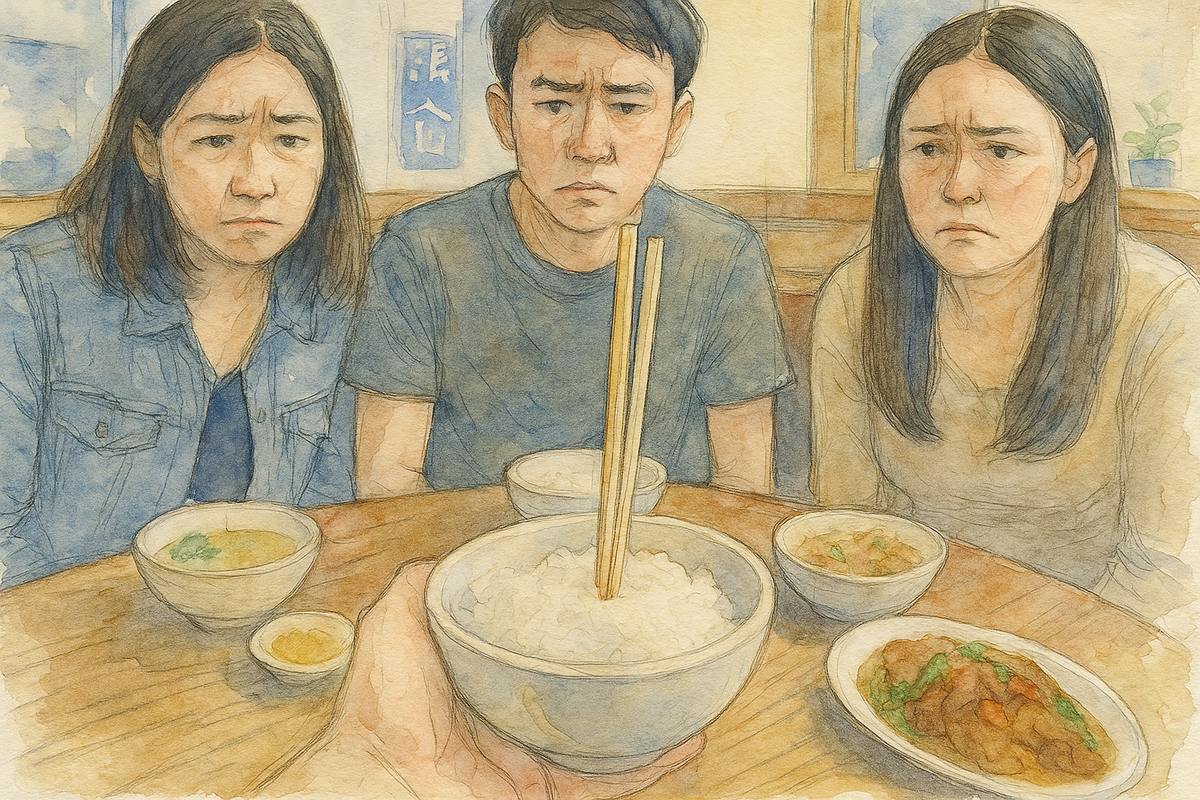Chopstick etiquette rules every visitor to Japan needs to know

Your chopstick behavior broadcasts who you are before you speak a word. Japanese dining culture reads these wooden sticks like social DNA. Seven rules separate competent diners from cultural disasters.
TL;DR
- Never stick chopsticks upright in rice (funeral ritual)
- Never pass food chopstick-to-chopstick (mimics passing cremated bones)
- Don't point with chopsticks at people or objects
- Don't wave them around while talking
- Use the opposite ends for taking from shared dishes
- Don't rub disposable chopsticks together (insults the establishment)
- Eat sushi in one bite when physically possible
The funeral taboos you must avoid
Don't stick chopsticks upright in rice
This looks exactly like incense sticks at Buddhist funerals. You've just turned your rice bowl into a death shrine. Japanese diners will freeze. The visual triggers ancestral worship imagery so strongly that even non-religious people feel it.
Quick essentials:
- Rest chopsticks horizontally on bowl rim or chopstick rest
- Vertical positioning in any food carries death symbolism
- Breaking this rule creates immediate, visceral discomfort
FAQ:
What if I do this accidentally? Remove them immediately. Quick "sumimasen" shows you recognize the mistake.
Does this apply to other utensils? Yes. No vertical sticking of anything into food.
Don't pass food chopstick to chopstick
This exactly copies how families pass cremated bone fragments at funerals. The practice, called hashi-watashi, makes people physically uncomfortable. Use a shared plate instead.
Quick essentials:
- Place food on plates for others to pick up themselves
- Direct transfer mimics Buddhist funeral bone-picking ritual
- Even family members follow this strictly
FAQ:
What if someone tries to give me food this way? Politely suggest using a plate. They probably don't know better.
Can I use the clean ends of my chopsticks? Still no. The gesture itself carries the taboo, not hygiene concerns.
The respect violations
Don't point with chopsticks
Chopsticks are sacred eating tools, not pointers. Using them to indicate people or objects degrades their spiritual purpose. This violation, yubi-bashi, breaks the connection between food and reverence.
Quick essentials:
- Use your hand or verbal cues to indicate things
- Chopsticks should only touch food, bowls, and rests
- Business relationships suffer from this mistake
FAQ:
Can I point at menu items? No. Put chopsticks down first, then point with your finger.
Does this include gesturing while talking? Absolutely. Keep them still or put them down during conversation.
Don't wave chopsticks around
Japanese meals create meditation spaces. Waving chopsticks, called hashi de sasu, shatters this calm. Keep movements small, controlled, purposeful.
Quick essentials:
- Movements should stay close to your plate
- Rest chopsticks between bites on holder or bowl rim
- Even casual meals require controlled movements
FAQ:
What counts as waving? Any gesture above table level. Keep them low and steady.
Is reaching for shared dishes okay? Reach calmly, take what you need, return smoothly. No flourishes.
Don't rub disposable chopsticks together
This announces "I think your chopsticks are garbage." The rubbing suggests you expect splinters from cheap utensils. It insults your host and the establishment's hospitality.
Quick essentials:
- Quality establishments provide smooth chopsticks
- If genuinely rough, handle discretely under the table
- The gesture questions the restaurant's standards
FAQ:
What if they actually have splinters? Smooth them quietly below table level or request new ones politely.
Do Japanese people ever do this? Rarely, and only very discretely when absolutely necessary.
The hygiene principles
Use opposite ends for shared dishes
Flip your chopsticks before taking from communal plates. Use the thick ends that haven't touched your mouth. This practice, toribashi, maintains hygiene while showing consideration.
Quick essentials:
- Flip chopsticks 180 degrees for shared dishes
- Return to normal position before eating
- Some restaurants provide separate serving chopsticks instead
FAQ:
Every single time? Yes. Even with family. Basic hygiene awareness.
What if serving chopsticks are provided? Use those instead of flipping yours.
The specialized rule
Eat sushi in one bite when possible
Nigiri sushi gets consumed whole. The chef balanced rice, fish, and wasabi for single-bite harmony. Multiple bites destroy this architecture and show disrespect for craftsmanship.
Quick essentials:
- Applies to nigiri and smaller maki rolls
- Large specialty rolls obviously get exemption
- Both chopsticks and hands work for nigiri
FAQ:
What if it's genuinely too large? Two quick bites beat struggling with an oversized piece.
Can I use my hands? For nigiri, yes. Traditional method actually.
Reading the room
Chopstick etiquette doesn't flex for context. Family dinners, business meals, convenience store bentos. Same rules. The cultural programming runs too deep for situational adjustment.
Watch Japanese diners. Notice the economy of movement. No wasted gestures. No dramatic flourishes. Just quiet competence that lets food and conversation lead.
Master these seven rules and you stop being the foreigner who doesn't get it. You become someone who respects the culture enough to learn its codes. The difference shows immediately.